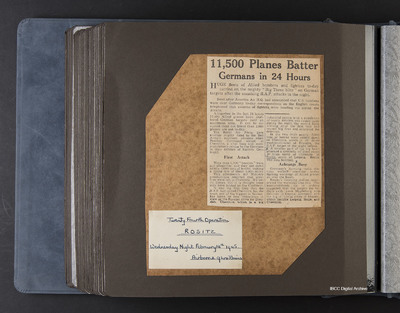Twenty fourth operation Rositz
Title
Twenty fourth operation Rositz
Description
A handwritten note giving brief details of the operation and a relevant newspaper cutting titled '11,500 planes batter Germans in 24 hours'.
Language
Type
Format
One handwritten note and a newspaper cutting on an album page
Publisher
Rights
This content is available under a CC BY-NC 4.0 International license (Creative Commons Attribution-NonCommercial 4.0). It has been published ‘as is’ and may contain inaccuracies or culturally inappropriate references that do not necessarily reflect the official policy or position of the University of Lincoln or the International Bomber Command Centre. For more information, visit https://creativecommons.org/licenses/by-nc/4.0/ and https://ibccdigitalarchive.lincoln.ac.uk/omeka/legal.
Contributor
Identifier
PPopeKMJ18010066
Transcription
11,500 Planes Batter Germans in 24 Hours
Huge fleets of Allied bombers and fighters to-day carried on the mighty “Big Three blitz” on German targets after the smashing R.A.F. attacks in the night.
Soon after America Air H.Q. had announced that the U.S. bombers were over Germany to-day correspondents on the English coasts telephoned that swarms of fighters were heading out across the Straits.
Altogether in the last 24 hours 11,500 Allied planes have shattered German targets over an enormous area. It can be assumed that not fewer than 2,000 planes are out to-day.
The Royal Air Force gave another mighty hand to the Red Army’s southern advance when Bomber Command struck at Chemnitz, a vital base and communications centre to the Germans in their defence of Eastern Germany.
First Attack
More than 1,300 “heavies” were out altogether, and they put down nearly 4,000 tons of bombs, making a round trip of about 1,000 miles.
This afternoon’s Air Ministry communique reported that great fires were left in Chemnitz. We lost 22 planes, but it is thought some may have landed on the Continent.
It was the first time that the R.A.F. had raided Chemnitz., but the town, one of the biggest in Saxony has taken on new importance in view of the Russian drive for Dresden. Chemnitz, which is a big industrial centre with a population of nearly 400,000, was raided twice during the night, the second force arriving after the first raid had caused big fires and saturated the defences.
In the two raids nearly 3,000 tons of bombs were rained down on Chemnitz, which is 39 miles west-south-west of Dresden, the R.A.F. target on the night before.
[inserted] X [/inserted] A smaller part of the big force attacked a synthetic oil plant about 40 miles north of Chemnitz, at [underlined] Rositz, [/underlined] south of Leipzig. Berlin was also bombed. [inserted] X [/inserted]
Achtungs Busy
Germany’s Achtung radio stations worked overtime to-day flashing warnings of Allied planes all over the Reich.
Reuter’s listening station interpreted the warnings like this. The announcements up to midday suggested that the targets for to-day’s raids were Magdeburg and Hanover in Central Germany, and the big industrial cities of Saxony, which include Leipzig, Halle, and Chemnitz.
[underlined]
Twenty Fourth Operation
ROSITZ
Wednesday Night February 14th 1945
Airborne 9hrs 33mins
[/underlined]
Huge fleets of Allied bombers and fighters to-day carried on the mighty “Big Three blitz” on German targets after the smashing R.A.F. attacks in the night.
Soon after America Air H.Q. had announced that the U.S. bombers were over Germany to-day correspondents on the English coasts telephoned that swarms of fighters were heading out across the Straits.
Altogether in the last 24 hours 11,500 Allied planes have shattered German targets over an enormous area. It can be assumed that not fewer than 2,000 planes are out to-day.
The Royal Air Force gave another mighty hand to the Red Army’s southern advance when Bomber Command struck at Chemnitz, a vital base and communications centre to the Germans in their defence of Eastern Germany.
First Attack
More than 1,300 “heavies” were out altogether, and they put down nearly 4,000 tons of bombs, making a round trip of about 1,000 miles.
This afternoon’s Air Ministry communique reported that great fires were left in Chemnitz. We lost 22 planes, but it is thought some may have landed on the Continent.
It was the first time that the R.A.F. had raided Chemnitz., but the town, one of the biggest in Saxony has taken on new importance in view of the Russian drive for Dresden. Chemnitz, which is a big industrial centre with a population of nearly 400,000, was raided twice during the night, the second force arriving after the first raid had caused big fires and saturated the defences.
In the two raids nearly 3,000 tons of bombs were rained down on Chemnitz, which is 39 miles west-south-west of Dresden, the R.A.F. target on the night before.
[inserted] X [/inserted] A smaller part of the big force attacked a synthetic oil plant about 40 miles north of Chemnitz, at [underlined] Rositz, [/underlined] south of Leipzig. Berlin was also bombed. [inserted] X [/inserted]
Achtungs Busy
Germany’s Achtung radio stations worked overtime to-day flashing warnings of Allied planes all over the Reich.
Reuter’s listening station interpreted the warnings like this. The announcements up to midday suggested that the targets for to-day’s raids were Magdeburg and Hanover in Central Germany, and the big industrial cities of Saxony, which include Leipzig, Halle, and Chemnitz.
[underlined]
Twenty Fourth Operation
ROSITZ
Wednesday Night February 14th 1945
Airborne 9hrs 33mins
[/underlined]
Collection
Citation
“Twenty fourth operation Rositz,” IBCC Digital Archive, accessed July 26, 2024, https://ibccdigitalarchive.lincoln.ac.uk/omeka/collections/document/9422.
Item Relations
This item has no relations.

